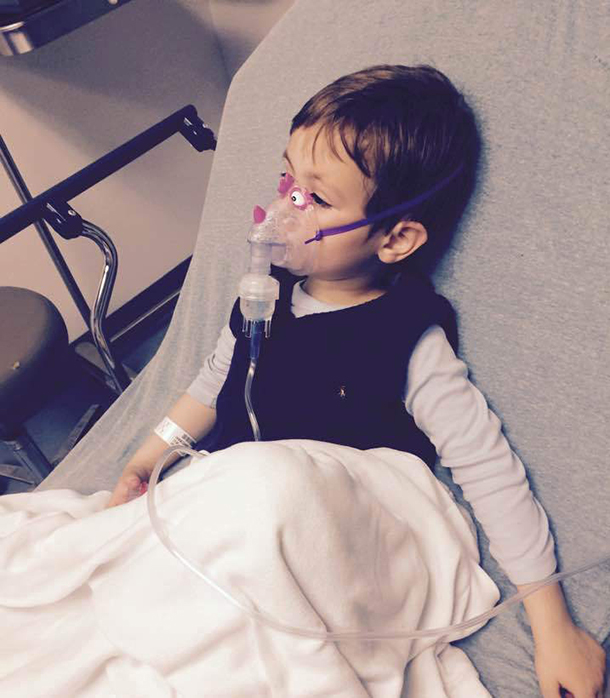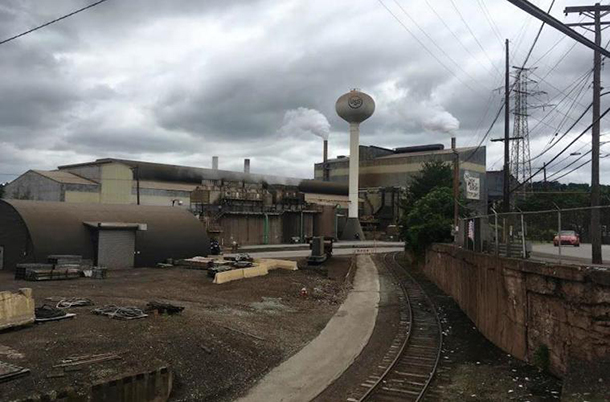Industrial Air Pollution as Unhealthful as Second Hand Tobacco Smoke
Air Date: Week of June 23, 2017

Four-year-old Ronan Annegarn, who lives in Pittsburgh’s Friendship neighborhood, was recently diagnosed with asthma. There is no history of asthma in his family. (Photo: Erin Halloran)
Children living near sources of pollution have virtually the same risk of developing asthma as those exposed to secondhand tobacco smoke, according to early results of a study in Western Pennsylvania. Carnegie Mellon researchers surveyed 1200 children living near the Pittsburgh area’s biggest polluters, as Liz Reid of The Allegheny Front and WESA reports.
Transcript
CURWOOD: Dangerous pollution can come in many forms, from dirty water to dirty air, and children are often the most susceptible. A survey conducted by Carnegie Mellon University of 1200 children living near some of biggest polluters in the Pittsburgh area shows that kids who live near sources of pollution run the same risk of developing asthma as those exposed to secondhand tobacco smoke. Allegheny Front contributor Liz Reid prepared this report.
REID: I’m sitting on a swing at the playground outside Woodland Hills Academy in Turtle Creek, Pennsylvania. I can’t see it or smell it… but according to data gathered by Carnegie Mellon University, I’m breathing in about eight parts per billion of nitrogen dioxide, and about five micrograms per cubic meter of black carbon.
That’s primarily because I’m downwind of US Steel’s Edgar Thompson Works in Braddock, just outside of Pittsburgh. The facility has been making steel for almost 150 years, and that entire time, nearby residents have been breathing in the pollution that it spews from its stacks, including the children of the Woodland Hills School District, and researchers are finding it's impacting their health.
GENTILE: For years we've had school nurses tell us a large percentage of children have asthma, that up to half the kids in our schools might have an asthma inhaler.
REID: That’s Deborah Gentile, an allergy and asthma specialist with the Pediatric Alliance. For two years, she’s been collecting data on asthma rates among elementary school children who live near sources of pollution, such as the steel mill in Braddock, Clairton Coke Works, and the Cheswick Power Station in Springdale.
GENTILE: It's running about 35 percent. And of those about two thirds of them or 24 percent actually know they have asthma. But we're diagnosing new asthma in about 10 percent.

Pollution from U.S. Steel's Edgar Thomson steel mill in Braddock eventually makes its way into the lungs of children in nearby school districts. (Photo: Liz Reid / 90.5 WESA)
REID: By comparison, the national asthma rate is about eight percent. In Allegheny County as a whole, it’s 13 percent.
Gentile’s method is straightforward. She sends children home with a simple, four-question survey for their caretakers to fill out, asking how often the child has experienced symptoms such as wheezing, coughing or trouble breathing. Gentile compared the results of her survey with the Carnegie Mellon data, and found, unsurprisingly, that kids who live near point sources of pollution are more likely to have asthma.
GENTILE: The kids that are exposed to the highest level of PM 2.5s as well as the highest level black carbon are twice as likely to have a diagnosis of asthma as those who are exposed to the lower. So that really has to be a call for public policy change to clean this air up.
REID: PM 2.5 is particulate matter that is 2 and a half microns in diameter. For comparison, a human hair is about sixty microns in diameter. PM 2.5 is the main ingredient in black carbon, a byproduct of burning fossil fuels, the concentrations of which CMU professor Albert Presto measured.
PRESTO: Particulate matter is solid or liquid material that floats around in the air, and they're actually little particles. Right? They’re not gas molecules, they're little, you know, solid or liquid drops. Particulate matter is made up of literally thousands of different components.
REID: Because these particles are so small, they embed deep into the lungs. Particulate matter has been linked to health problems such as lung cancer, asthma attacks and even premature death, according to the American Lung Association. Nitrogen oxide also contributes to kids developing asthma or having more frequent attacks. Gentile says she’s particularly troubled by another aspect of the data.
GENTILE: Near these point sources of pollution we tend to see more minority families as well as more lower socioeconomic status and that's what they find in other cities as well. These are the people who can't afford to live elsewhere.
REID: Gentile says the pollution, and the asthma it causes, have far-reaching consequences in a child’s life.
GENTILE: As a doctor who takes care of children with asthma, I see them missing school, not being able to participate in activities, they're not sleeping at night, their parents aren't sleeping at night. It has a tremendous impact on their life.
REID: Gentile and her team are currently compiling all of the data from her surveys, and expect to put out a full report out later this year, with the goal of spurring government action. To start, she’d like to see asthma screenings mandated in schools. And she’s hopeful the data showing that a third of children near these pollution sources have asthma will be the push policymakers need to clean up the air in Allegheny County.
I’m Liz Reid.
CURWOOD: Liz Reid reports for public radio station WESA and the Allegheny Front.
Links
Living on Earth wants to hear from you!
Living on Earth
62 Calef Highway, Suite 212
Lee, NH 03861
Telephone: 617-287-4121
E-mail: comments@loe.org
Newsletter [Click here]
Donate to Living on Earth!
Living on Earth is an independent media program and relies entirely on contributions from listeners and institutions supporting public service. Please donate now to preserve an independent environmental voice.
NewsletterLiving on Earth offers a weekly delivery of the show's rundown to your mailbox. Sign up for our newsletter today!
 Sailors For The Sea: Be the change you want to sea.
Sailors For The Sea: Be the change you want to sea.
 The Grantham Foundation for the Protection of the Environment: Committed to protecting and improving the health of the global environment.
The Grantham Foundation for the Protection of the Environment: Committed to protecting and improving the health of the global environment.
 Contribute to Living on Earth and receive, as our gift to you, an archival print of one of Mark Seth Lender's extraordinary wildlife photographs. Follow the link to see Mark's current collection of photographs.
Contribute to Living on Earth and receive, as our gift to you, an archival print of one of Mark Seth Lender's extraordinary wildlife photographs. Follow the link to see Mark's current collection of photographs.
 Buy a signed copy of Mark Seth Lender's book Smeagull the Seagull & support Living on Earth
Buy a signed copy of Mark Seth Lender's book Smeagull the Seagull & support Living on Earth

